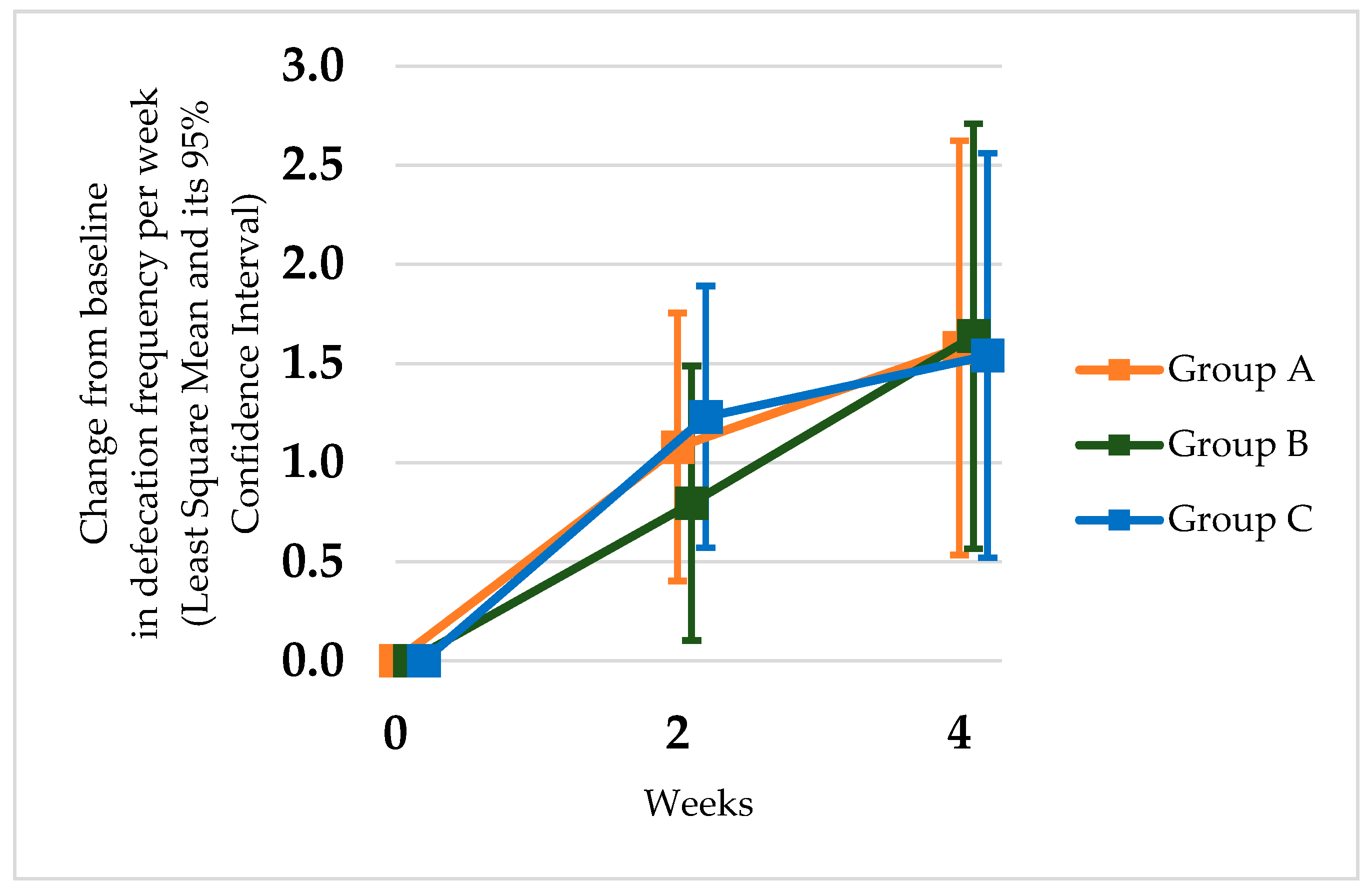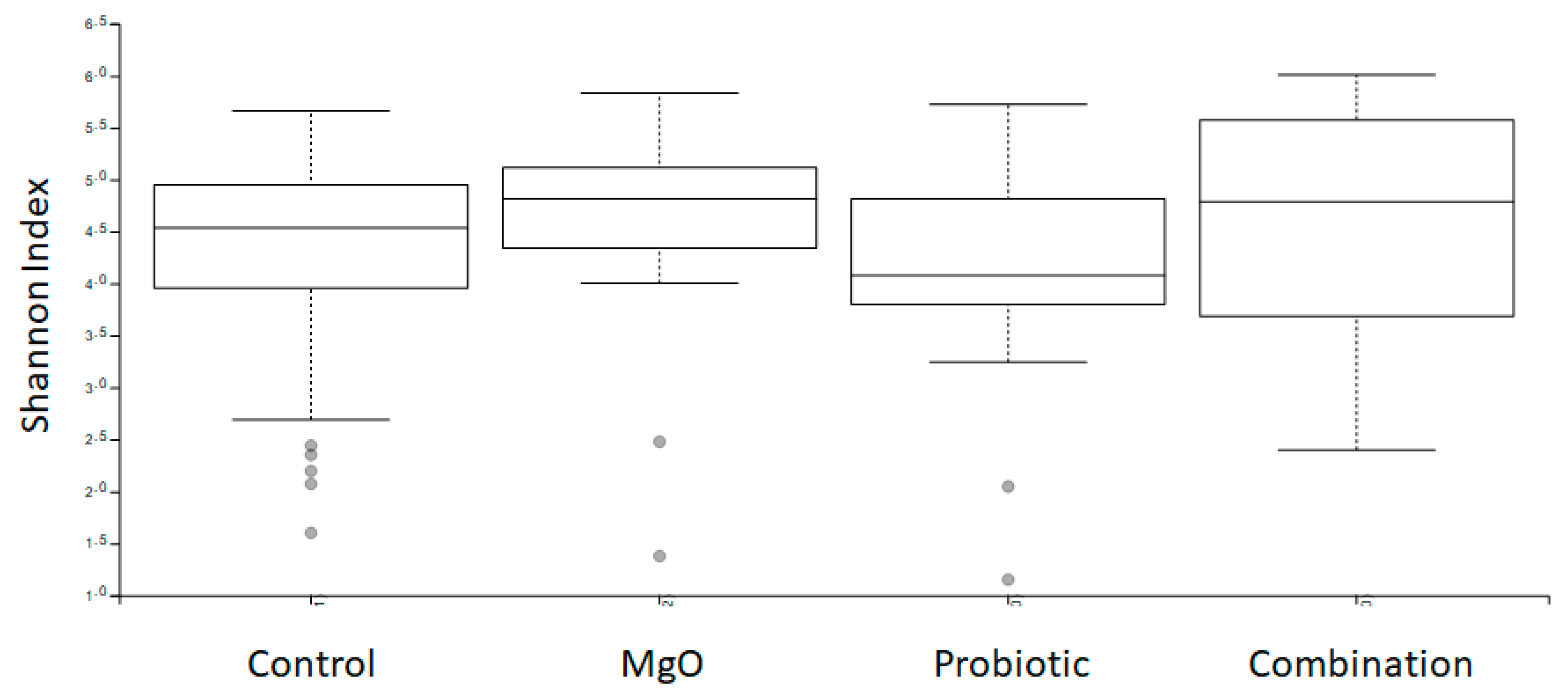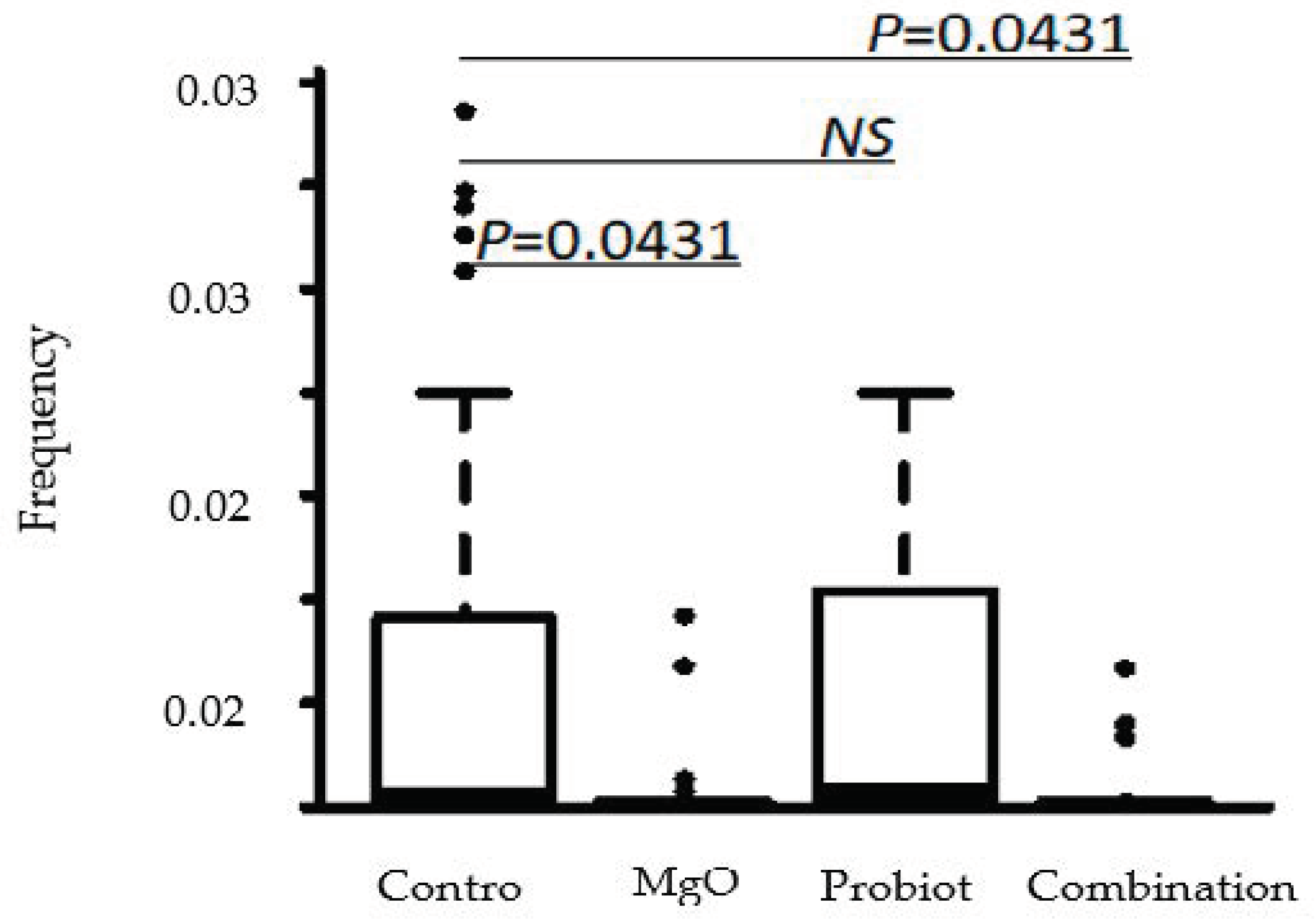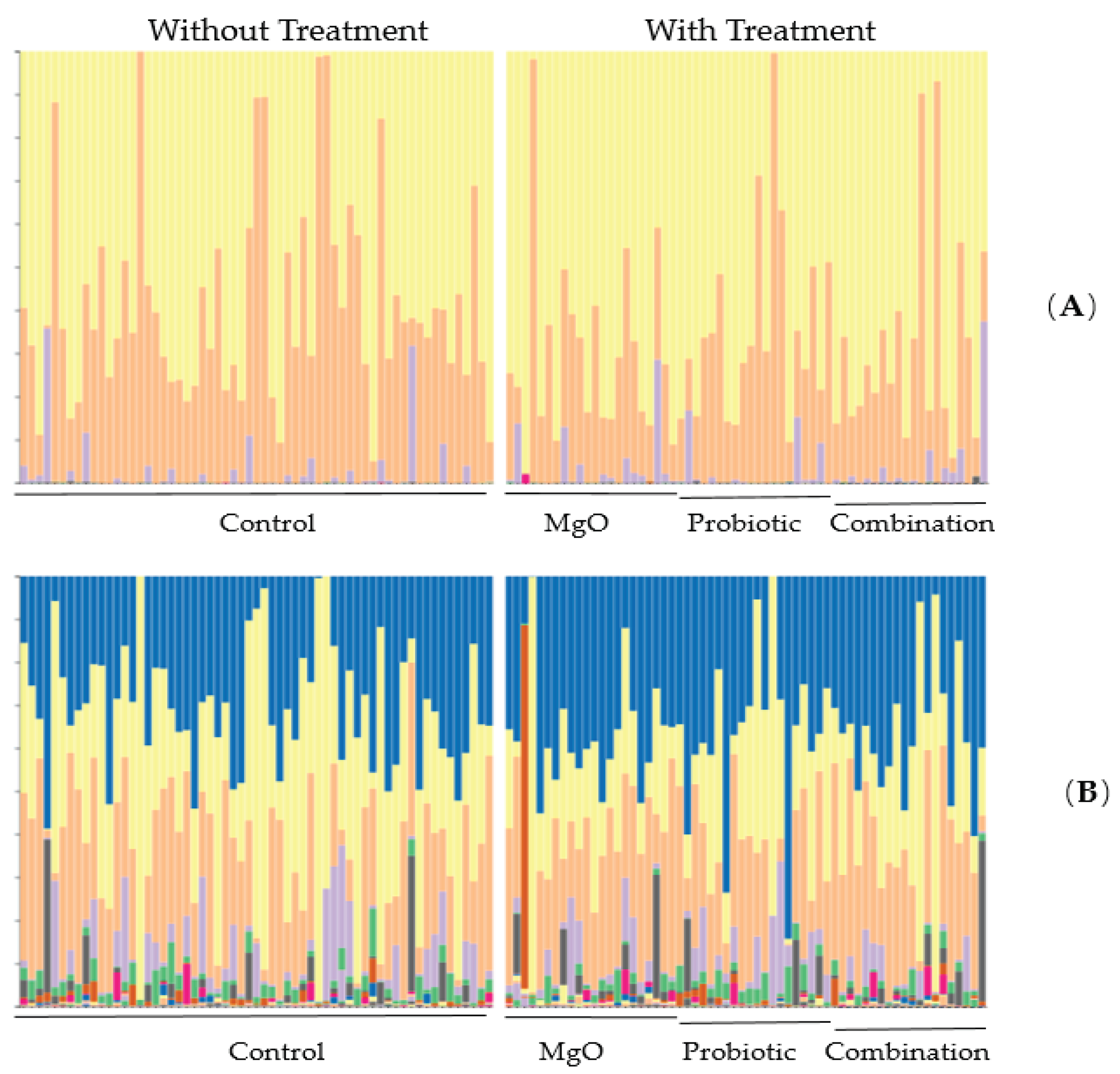Lactobacillus reuteri DSM 17938 and Magnesium Oxide in Children with Functional Chronic Constipation: A Double-Blind and Randomized Clinical Trial
Abstract
1. Introduction
2. Methods
2.1. Patients
2.2. Study Products
2.3. Outcomes
2.4. Sample Size
2.5. Statistical Analyses
3. Results
4. Discussion
5. Conclusions
Author Contributions
Funding
Acknowledgments
Conflicts of Interest
Abbreviations
| MgO | Magnesium oxide |
| L. reuteri | Lactobacillus reuteri DSM 17938 |
| FMT | Fecal microbiota transplantation |
| Lcr | Lactobacillus casei rhamnosus |
References
- Tabbers, M.M.; DiLorenzo, C.; Berger, M.Y.; Faure, C.; Langendam, M.W.; Nurko, S.; Staiano, A.; Vandenplas, Y.; Benninga, M.A. Evaluation and treatment of functional constipation in infants and children: Evidence-based recommendations from ESPGHAN and NASPGHAN. J. Pediatr. Gastroenterol. Nutr. 2014, 58, 258–274. [Google Scholar] [CrossRef] [PubMed]
- Andrews, C.N.; Storr, M. The pathophysiology of chronic constipation. Can. J. Gastroenterol. 2011, 25, 16B–21B. [Google Scholar] [CrossRef] [PubMed]
- Hill, C.; Guarner, F.; Reid, G.; Gibson, G.R.; Merenstein, D.J.; Pot, B.; Morelli, L.; Canani, R.B.; Flint, H.J.; Salminen, S.; et al. Expert consensus document. The International Scientific Association for Probiotics and Prebiotics consensus statement on the scope and appropriate use of the term probiotic. Nat. Rev. Gastroenterol. Hepatol. 2014, 11, 506–514. [Google Scholar] [CrossRef] [PubMed]
- Horvath, A.; Szajewska, H. Probiotics, prebiotics, and dietary fiber in the management of functional gastrointestinal disorders. World Rev. Nutr. Diet 2013, 108, 40–48. [Google Scholar] [PubMed]
- Tabbers, M.M.; Benninga, M.A. Constipation in children: Fibre and probiotics. BMJ Clin. Evid. 2015, 2015. [Google Scholar]
- Levy, E.I.; Lemmens, R.; Vandenplas, Y.; Devreker, T. Functional constipation in children: Challenges and solutions. Pediatr. Health Med. Ther. 2017, 8, 19–27. [Google Scholar] [CrossRef]
- Toshifumi, O.; Shigeo, K.; Yuriko, N.; Nobuhiro, S. Gut Microbiota and Chronic Constipation: A Review and Update. Front. Med. 2019, 6, 19. [Google Scholar]
- Johnson, C.L.; Versalovic, J. The Human Microbiome and its Potential Importance to Pediatrics. Pediatrics 2012, 129, 950–960. [Google Scholar] [CrossRef]
- Coccorullo, P.; Strisciuglio, C.; Martinelli, M.; Miele, E.; Greco, L.; Staiano, A. Lactobacillus reuteri (DSM17938) in infants with functional chronic constipation: A double-blind, randomized, placebo-controlled study. J. Pediatr. 2010, 157, 598–602. [Google Scholar] [CrossRef]
- Mori, S.; Tomita, T.; Fujimura, K.; Asano, K.; Ogawa, T.; Yamasaki, T.; Kondo, T.; Kono, T.; Tozawa, K.; Oshima, T.; et al. A randomized double-blind placebo-controlled trial on the effect of magnesium oxide in patients with chronic constipation. J. Neurogastroenterol. Motil. 2019, 25, 563–575. [Google Scholar] [CrossRef]
- Benninga, M.A.; Nurko, S.; Faure, C.; Hyman, P.E.; St James Roberts, I.; Schechter, N.L. Childhood functional gastrointestinal disorders: Neonate/toddler. Gastroenterology 2016, 150, 1443–1455. [Google Scholar] [CrossRef]
- Lewis, S.J.; Heaton, K.W. Stool form scale as a useful guide to intestinal transit time. Scand. J. Gastroenterol. 1997, 32, 920–924. [Google Scholar] [CrossRef] [PubMed]
- Wu, R.Y.; Pasyk, M.; Wang, B.; Forsythe, P.; Bienenstock, J.; Mao, Y.K.; Kunze, W.A. Spatiotemporal maps reveal regional differences in the effects on gut motility for Lactobacillus reuteri and rhamnosus strains. Neurogastroenterol. Motil. 2013, 25, e205–e214. [Google Scholar] [CrossRef] [PubMed]
- Bueno, L.; De Ponti, F.; Fried, M.; Kullak-Ublick, G.A.; Kwiatek, M.A.; Pohl, D.; Quigley, E.M.M.; Tack, J.; Talley, N.J. Serotonergic and non-serotonergic targets in the pharmacotherapy of visceral hypersensitivity. Neurogastroenterol. Motil. 2007, 19, 89–119. [Google Scholar] [CrossRef] [PubMed]
- Salminen, S.; Salminen, E. Lactulose, lactic acid bacteria, intestinal microecology and mucosal protection. Scand. J. Gastroenterol. Suppl. 1997, 222, 45–48. [Google Scholar] [CrossRef] [PubMed]
- Huang, R.; Hu, J. Positive Effect of Probiotics on Constipation in Children: A Systematic Review and Meta-Analysis of Six Randomized Controlled Trials. Front. Cell. Infect. Microbiol. 2017, 7, 1–9. [Google Scholar] [CrossRef] [PubMed]
- Tatsuki, M.; Miyazawa, R.; Tomomasa, T.; Ishige, T.; Nakazawa, T.; Arakawa, H. Serum magnesium concentration in children with functional constipation treated with magnesium oxide. World J. Gastroenterol. 2011, 17, 779–783. [Google Scholar] [CrossRef]
- Bu, L.N.; Chang, M.H.; Ni, Y.H.; Chen, H.L.; Cheng, C.C. Lactobacillus casei rhamnosus Lcr35 in children with chronic constipation. Pediatr. Int. 2007, 49, 485–490. [Google Scholar] [CrossRef]
- Wojtyniak, K.; Horvath, A.; Dziechciarz, P.; Szajewska, H. Lactobacillus casei rhamnosus Lcr35 in the Management of Functional Constipation in Children: A Randomized Trial. J. Pediatr. 2017, 184, 101–105. [Google Scholar] [CrossRef]
- Russo, M.; Giugliano, F.P.; Quitadamo, P.; Mancusi, V.; Miele, E.; Staiano, A. Efficacy of a mixture of probiotic agents as complementary therapy for chronic functional constipation in childhood. Ital. J. Pediatr. 2017, 43, 1–7. [Google Scholar] [CrossRef]
- Gutiérrez-Castrellón, P.; Indrio, F.; Bolio-Galvis, A.; Jiménez-Gutiérrez, C.; Jimenez-Escobar, I.; López-Velázquez, G. Efficacy of Lactobacillus reuteri DSM 17938 for infantile colic: Systematic review with network meta-analysis. Medicine 2017, 96, e9375. [Google Scholar] [CrossRef] [PubMed]
- Kunze, W.A.; Mao, Y.K.; Wang, B.; Huizinga, J.D.; Ma, X.; Forsythe, P.; Bienenstock, J.L. actobacillus reuteri enhances excitability of colonic AH neurons by inhibiting calcium-dependent potassium channel opening. J. Cell. Mol. Med. 2009, 13, 2261–2270. [Google Scholar] [CrossRef] [PubMed]
- Wang, B.; Mao, Y.K.; Diorio, C.; Wang, L.; Huizinga, J.D.; Bienenstock, J.; Kunze, W. Lactobacillus reuteri ingestion and IKCa channel blockade have similar effects on rat colon motility and myenteric neurones. Neurogastroenterol. Motil. 2010, 22, 98–107. [Google Scholar] [PubMed]
- Bär, F.; Von Koschitzky, H.; Roblick, U.; Bruch, H.P.; Schulze, L.; Sonnenborn, U.; Wedel, T. Cell-free supernatants of Escherichia coli Nissle 1917 modulate human colonic motility: Evidence from an In Vitro organ bath study. Neurogastroenterol. Motil. 2009, 21, 559–666. [Google Scholar] [CrossRef]
- Tian, H.; Ge, X.; Nie, Y.; Yang, L.; Ding, C.; McFarland, L.V.; Zhang, X.; Chen, Q.; Gong, J.; Li, N. Fecal microbiota transplantation in patients with slow-transit constipation: A randomized, clinical trial. PLoS ONE 2017, 12, e0171308. [Google Scholar] [CrossRef]
- De Meij, T.G.J.; De Groot, E.F.J.; Eck, A.; Budding, A.E.; Kneepkens, C.M.F.; Benninga, M.A.; Savelkoul, P.H. Characterization of microbiota in children with chronic functional constipation. PLoS ONE 2016, 11, e0164713. [Google Scholar] [CrossRef]
- Nguyen, N.T.; Grelling, N.; Wetteland, C.L.; Rosario, R.; Liu, H. Antimicrobial activities and mechanisms of magnesium oxide nanoparticles (nMgO) against pathogenic bacteria, yeasts, and biofilms. Sci. Rep. 2018, 8, 16260. [Google Scholar] [CrossRef]






| Baseline Characteristics of Subjects | ||||
|---|---|---|---|---|
| Group A | Group B | Group C | p-Value | |
| n | 20 | 19 | 21 | |
| Male: Female | 11:9 | 10:9 | 12:9 | 0.960 |
| Age, Months/Mean (SD) | 32.7 (15.9) | 40.3 (17.4) | 34.2 (15.2) | 0.301 |
| Defecation Frequency Per Week/Mean (SD) | 1.68 (1.51) | 1.71 (1.35) | 1.50 (0.82) | 0.848 |
| Bristol Stool Form Scale/Mean (SD) | 2.4 (1.69) | 3.0 (1.57) | 2.4 (1.41) | 0.390 |
| Change from Baseline in Defecation Frequency Per Week | |||
|---|---|---|---|
| Group | Weeks | Least Square Mean (95% CI) | p-Value |
| A | 2 | 1.08 (0.40, 1.75) | 0.002 |
| 4 | 1.58 (0.53, 2.62) | 0.004 | |
| B | 2 | 0.79 (0.10, 1.49) | 0.025 |
| 4 | 1.64 (0.57, 2.71) | 0.003 | |
| C | 2 | 1.23 (0.57, 1.89) | 0.000 |
| 4 | 1.54 (0.52, 2.56) | 0.004 | |
| Change from Baseline in Bristol Stool Form Scale | |||
|---|---|---|---|
| Group | Weeks | Least Square Mean (95% CI) | p-Value |
| A | 2 | 0.88 (0.22, 1.54) | 0.010 |
| 4 | 0.62 (−0.07, 1.31) | 0.079 | |
| B | 2 | 0.77 (0.09, 1.46) | 0.028 |
| 4 | 0.88 (0.17, 1.59) | 0.017 | |
| C | 2 | 1.29 (0.64, 1.94) | 0.000 |
| 4 | 1.61 (0.93, 2.28) | 0.000 | |
© 2020 by the authors. Licensee MDPI, Basel, Switzerland. This article is an open access article distributed under the terms and conditions of the Creative Commons Attribution (CC BY) license (http://creativecommons.org/licenses/by/4.0/).
Share and Cite
Kubota, M.; Ito, K.; Tomimoto, K.; Kanazaki, M.; Tsukiyama, K.; Kubota, A.; Kuroki, H.; Fujita, M.; Vandenplas, Y. Lactobacillus reuteri DSM 17938 and Magnesium Oxide in Children with Functional Chronic Constipation: A Double-Blind and Randomized Clinical Trial. Nutrients 2020, 12, 225. https://doi.org/10.3390/nu12010225
Kubota M, Ito K, Tomimoto K, Kanazaki M, Tsukiyama K, Kubota A, Kuroki H, Fujita M, Vandenplas Y. Lactobacillus reuteri DSM 17938 and Magnesium Oxide in Children with Functional Chronic Constipation: A Double-Blind and Randomized Clinical Trial. Nutrients. 2020; 12(1):225. https://doi.org/10.3390/nu12010225
Chicago/Turabian StyleKubota, Megumi, Kazuya Ito, Kazuhiko Tomimoto, Mitsuharu Kanazaki, Kei Tsukiyama, Akio Kubota, Haruo Kuroki, Mitsugu Fujita, and Yvan Vandenplas. 2020. "Lactobacillus reuteri DSM 17938 and Magnesium Oxide in Children with Functional Chronic Constipation: A Double-Blind and Randomized Clinical Trial" Nutrients 12, no. 1: 225. https://doi.org/10.3390/nu12010225
APA StyleKubota, M., Ito, K., Tomimoto, K., Kanazaki, M., Tsukiyama, K., Kubota, A., Kuroki, H., Fujita, M., & Vandenplas, Y. (2020). Lactobacillus reuteri DSM 17938 and Magnesium Oxide in Children with Functional Chronic Constipation: A Double-Blind and Randomized Clinical Trial. Nutrients, 12(1), 225. https://doi.org/10.3390/nu12010225







